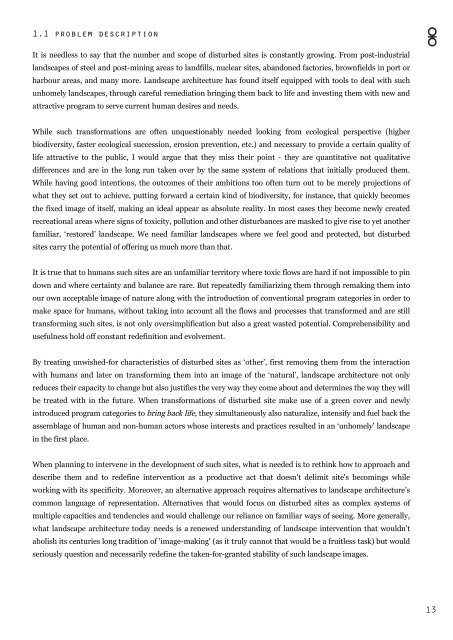Unfamiliar Territory_Research
You also want an ePaper? Increase the reach of your titles
YUMPU automatically turns print PDFs into web optimized ePapers that Google loves.
1.1 problem description<br />
It is needless to say that the number and scope of disturbed sites is constantly growing. From post-industrial<br />
landscapes of steel and post-mining areas to landfills, nuclear sites, abandoned factories, brownfields in port or<br />
harbour areas, and many more. Landscape architecture has found itself equipped with tools to deal with such<br />
unhomely landscapes, through careful remediation bringing them back to life and investing them with new and<br />
attractive program to serve current human desires and needs.<br />
⚮<br />
While such transformations are often unquestionably needed looking from ecological perspective (higher<br />
biodiversity, faster ecological succession, erosion prevention, etc.) and necessary to provide a certain quality of<br />
life attractive to the public, I would argue that they miss their point - they are quantitative not qualitative<br />
differences and are in the long run taken over by the same system of relations that initially produced them.<br />
While having good intentions, the outcomes of their ambitions too often turn out to be merely projections of<br />
what they set out to achieve, putting forward a certain kind of biodiversity, for instance, that quickly becomes<br />
the fixed image of itself, making an ideal appear as absolute reality. In most cases they become newly created<br />
recreational areas where signs of toxicity, pollution and other disturbances are masked to give rise to yet another<br />
familiar, ‘restored’ landscape. We need familiar landscapes where we feel good and protected, but disturbed<br />
sites carry the potential of offering us much more than that.<br />
It is true that to humans such sites are an unfamiliar territory where toxic flows are hard if not impossible to pin<br />
down and where certainty and balance are rare. But repeatedly familiarizing them through remaking them into<br />
our own acceptable image of nature along with the introduction of conventional program categories in order to<br />
make space for humans, without taking into account all the flows and processes that transformed and are still<br />
transforming such sites, is not only oversimplification but also a great wasted potential. Comprehensibility and<br />
usefulness hold off constant redefinition and evolvement.<br />
By treating unwished-for characteristics of disturbed sites as ‘other’, first removing them from the interaction<br />
with humans and later on transforming them into an image of the ‘natural’, landscape architecture not only<br />
reduces their capacity to change but also justifies the very way they come about and determines the way they will<br />
be treated with in the future. When transformations of disturbed site make use of a green cover and newly<br />
introduced program categories to bring back life, they simultaneously also naturalize, intensify and fuel back the<br />
assemblage of human and non-human actors whose interests and practices resulted in an ‘unhomely’ landscape<br />
in the first place.<br />
When planning to intervene in the development of such sites, what is needed is to rethink how to approach and<br />
describe them and to redefine intervention as a productive act that doesn't delimit site's becomings while<br />
working with its specificity. Moreover, an alternative approach requires alternatives to landscape architecture’s<br />
common language of representation. Alternatives that would focus on disturbed sites as complex systems of<br />
multiple capacities and tendencies and would challenge our reliance on familiar ways of seeing. More generally,<br />
what landscape architecture today needs is a renewed understanding of landscape intervention that wouldn't<br />
abolish its centuries long tradition of 'image-making' (as it truly cannot that would be a fruitless task) but would<br />
seriously question and necessarily redefine the taken-for-granted stability of such landscape images.<br />
13


